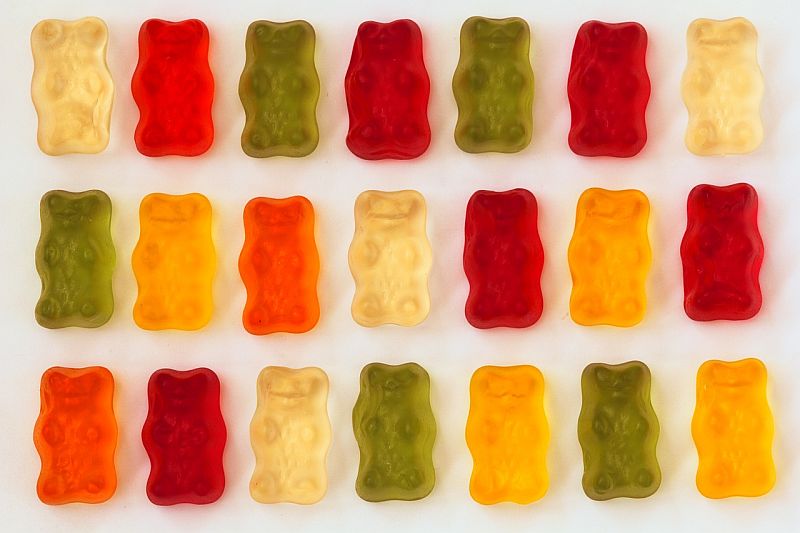Can dogs eat gummy bears? If you have dogs and children, there might be times when you catch your pet eating foods that you aren’t sure are safe for him. Gummy bears and worms are examples of human snacks your pooch might get that should worry you. These sugary edibles contain xylitol, which is really bad for the health of your animals.
Can Dogs Eat Gummy Bears?

Gummy bears might be a yummy treat but they are toxic for your canines. In fact, they are actually on the list of the Top 10 most dangerous foods for dogs of any age or breed. Too many gummy bears can actually lead to poisoning. Left untreated, it can be fatal to your dog.
Anything sweet can put your pup at risk of diabetes or obesity. But gummy bears are especially harmful because they are made with Xylitol, which is used as a sugar substitute. Most of the products you see that are “sugar-free” contain this chemical. It is high in calories and just a small amount can cause hypoglycemia or low blood sugar.
Xylitol can also cause your pet to have cavities and can make your pet have excessive drool. If you have a large breed dog that makes a mess when he slobbers, get ready to clean up a lot of spit and slobber… Not fun.
Gummy bears and other candies made with xylitol like candy corn, jelly beans, gum, and candy canes can get stuck in your pet’s teeth. If you don’t brush your pooch’s teeth on a regular basis, these clumps of sugar can cause tooth decay.
Gummy Bears Can Be Dangerous For Your Dog

Xylitol doesn’t just put your dog at risk of hypoglycemia. Consuming this harmful ingredient can also cause seizures, liver failure, and even death. Xylitol gets absorbed quickly into the bloodstream after being eaten, which causes a surge of insulin to quickly be released from the pancreas.
As all of this insulin enters the body, it causes a rapid decrease in blood sugar (hypoglycemia). The first 60 minutes after eating gummy bears is the most critical. If your dog’s blood sugar does not rise back to safe levels after this time period, it can lead to death.
It can take as little as 50 milligrams of xylitol per pound of weight to cause hypoglycemia in a dog – 100 mg per kg. The higher the dose, the more at risk your pet will be for liver failure. There are symptoms of xylitol poisoning to watch for, which usually present within 15-30 minutes after your dog has eaten gummy bears.
Symptoms of Xylitol Poisoning
If your dog consumes gummy bears, immediately call your veterinarian or the Pet Poison Helpline at 1-800-213-6680. Do not try to make your pet vomit up the dangerous products, unless under the instruction of your veterinarian. Vomiting can make hypoglycemia worse.
Signs of xylitol poisoning to watch for include:
- Vomiting
- Diarrhea
- Weakness
- Accelerated heart rate
- Abnormal stool (looks tarry)
- Lack of coordination
- Difficulty walking and standing
- Lethargy
- Tremors
- Seizures
- Coma

The prognosis for Recovery from Eating Gummy Bears is Good
Even though gummy bears are harmful to dogs, the prognosis for a dog who has consumed these snacks is good if treatment is started early enough, or if dogs are healthy enough for their bodies to balance out the hypoglycemia in time.
If liver failure or a bleeding disorder occurs, recovery is less likely. And if your pet ends up in a coma, recovery is very unlikely. At this point, your pet’s body might have too much damage to allow for recuperation.
Keep the Gummy Bears Out of Your Pet’s Reach
If you want to ensure your pet’s good health, keep gummy bears, and any other products which may contain Xylitol, out of their reach. We would like to point out that some research indicates that the brand Haribo claims not to use this chemical in their product.
However, you should always check the ingredients lists. And just because there is no Xylitol in Haribo brands does not mean that you should give these gummy bears to your pet. They are still dangerous too.
Xylitol Toxicity in Dogs

Kassidy Shepperd is the editor in chief for Canine-Prime.com. She is is a dog lover/trainer, a freelance writer and a volunteer at many pet rescue and shelter centers. Kassidy is based in Colorado and regularly writes for dog related magazines and blogs.


